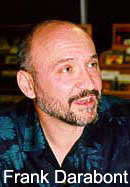
CAPTAIN BLOOD
April 8th, 2004
Script Review: CAPTAIN BLOOD
by Darwin Mayflower
WARNING: SPOILERS!
(08/29/00)

I was excited to read CAPTAIN BLOOD. Two of my favorite screenwriters worked on the script -- Jonathan Hensleigh (DIE HARD WITH A VENGEANCE) and Frank Darabont (THE SHAWSHANK REDEMPTION).
When one eagerly awaits something, painting it in his own style inside his head, its hard for the thing in question to live up to your own thoughts and theres the inevitable letdown. But for once...something highly anticipated didnt disappoint.
The thing that strikes you about CAPTAIN BLOOD is its retro-coolness. Its a swashbuckling epic (with all that that entails). And we havent seen a good representation of this genre -- where boats do battle in high seas and people shout "Ship ahoy!" and "Land ho!" and cannons roar -- for God knows how long.
CAPTAIN BLOOD started out as a book by Rafael Sabatini. It was made into a silent film. And then remade in 1935 by director Michael Curtiz. When the original lead dropped out of the movie Warner Bros. gave up-and-comer Errol Flynn a break and handed him his first major role. A role that would catapult him (because of the movie itself and his young enthusiasm) into a worldwide star.
Many consider CAPTAIN BLOOD to be the best pirate movie ever made. The book is thought of as an unsung gem.
Neither book nor movie is mentioned on the cover of this script (which Darabont rewrote with Chuck Russell). And the script, after its first act, doesnt have much in common with their plots.
What it does take, instead of dialogue or their three-act structure, is their spirit. The writers here know exactly what theyre doing. And with infectious ebullience, they craft a high-seas adventure that introduces us to Spanish pirates and a slave island where the condemned mine for emeralds and a criminal hideaway where there is no violence, but one can sell a woman for a handsome price.
And lets not forget the duels. Two men fighting to their deaths. Jumping atop tables and climbing walls. Metal clashing. Sparks flying. Each man focused sharply, knowing that one false move can mean his life. Macho-madness at its peak...and most exhilaratingly fun.
There are three duels in this movie. The best one being the fight between Don Diego ("the most powerful and infamous pirate captain in the Caribbean") and Major Edward Bishop. The cowardly Bishop is dueling with Diego while Diego is chained by one hand to a wall. Diego finds a brilliantly entertaining, painful way out of his predicament.
Peter Blood is a doctor who is sold into slavery and put to work erecting a bridge in Port Royal. When Diego and his Spanish pirates attack the unprepared Port Royal, Blood and his fellow prisoners escape -- taking Diegos galleon with them. With no ship to leave in, Diego is quickly captured by the British.
With his ragtag crew of shipmates, Blood (now Captain Blood) sets off for the slave island Mayagana, where some of his fellow rebel soldiers are being worked to death in the mines.
Theyll need a bigger crew and more weapons. So Blood goes into the pirating business (in some funny, nonviolent rip-offs -- this is our hero, you know) to collect money.
What I really liked about this script is that the writers set up not one, not two, but three villains who are hell-bent on murdering Blood.
Theres Major Edward Bishop, who wanted to hang Blood when he was a slave but was stopped by Bloods "owner" (the governors beautiful daughter Arabella Prescott, who Blood is in love with).
Don Diego, whose escape Blood foiled. And who was subsequently jailed because of it.
And Don Marquez. The man that wanted to buy Blood at a slave auction but was outbid by Arabella.
In one of the scripts many epic battles (all post-BRAVEHEART violent), Blood and his crew storm Marquez island and set the slaves free.
This scene, along with Diegos attack at Port Royal, are so extraordinarily crafty and adroit that, even as a script, it has you on the edge of your seat and laughing aloud like a kid on a roller coaster.
Of course we have the ineluctable finale with Blood facing off against his archenemies. But the writers give you a nice little tweak to keep you smiling: in a fantastic twist Blood does battle with Diego and Bishop (who also hate each other and take turns between fighting Blood to fight each other).
Had this been made in 1935 or 1940 maybe I wouldnt be so impressed by it. Back then you could see a couple of good swashbucklers and wait for more next week. But we dont have them anymore and its a potent genre we seem to have forgotten. Sometimes you have to move backwards, revitalizing something that thrived in the past, to give audiences something that theyll enjoy.
I just think of it this way --
Massive ships cutting through the ocean while their colossal cannons explode all around, tearing apart the opposing craft. Men jumping from ship to ship, brandishing swords and tossing them around with easy, casual finesse. Men swinging across the length of a boat, dagger in mouth, like a silence Tarzan. Or -- my favorite -- sticking a knife in a sail and taking a pleasant ride to the ships deck.
These old-school antics are compulsively engrossing.
I dont know who wrote what here. But I look at this as another example of Hensleighs considerable talent. He doesnt get much credit in Hollywood (fans like his work; critics are mad because he doesnt turn out HAPPINESS or turgid trash like MAGNOLIA) but I appreciate what he can do as a writer.
Darabont we all know about. Chuck Russell (THE MASK, BLESS THE CHILD) was supposed to direct this. Which could be disastrous. (Id rather see a readymade pirate maestro like Paul Verhoeven, or even Tony Scott, direct it.)
As I read this, rocking along, back in infantile glee (as when youre a kid and see a spectacular movie for the first time), riding along with this motley crew, blasting away alongside them...I asked myself: How in the hell did I forget -- and then neglect -- this genre?
-- Darwin Mayflower.
More recent articles in Script Reviews
Only logged-in members can comment. You can log in or join today for free!
No comments posted.
Advertisement

















